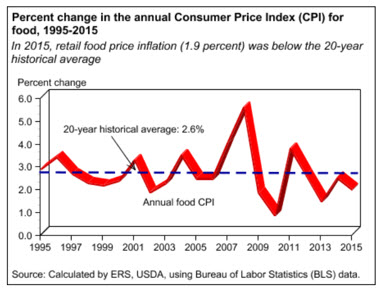WASHINGTON, July 27, 2016 - With recent declines in prices
for poultry, egg and dairy products, USDA’s Economic Research Service predicts prices
for food-at-home will rise between 0.25 percent and 1.25 percent in 2016 –
reflecting a rate of inflation below the 20-year historical average of 2.5
percent and incredible values for U.S. consumers.
Lower transportation costs due to deflated oil prices as well as the strength of the U.S. dollar placed additional downward pressure on food prices in the first half of 2016, ERS said in a report. Here are some other highlights:
Prices for poultry are 3.4 percent lower than last year. Retail chicken price inflation has remained relatively low into 2016 partly due to an increase in broiler production.
Egg prices are 26.9 percent below June 2015 levels. Prices spiked last year due to the Avian Influenza outbreak, which decreased the table-egg-laying flocks in the Midwest and Pacific Northwest by 11 percent (33 million egg layers).
Prices for dairy products are 2.2 percent lower than they were in June 2015, which ERS says “followed global patterns.” However, dairy imports have recently declined from very high levels in the first quarter of 2016, and domestic demand for dairy is expected to be high.
ERS predicts dairy product prices will decrease between 1.5 and 0.5 percent in 2016 but rise between 1.5 and 2.5 percent in 2017.
Prices for fresh fruit are still 3.3 percent higher than in June 2015. ERS expects fresh fruit prices to increase 1.5 to 2.5 percent in 2016 and 1 to 2 percent in 2017. Fresh vegetable prices are 0.2 percent higher than June 2015. The agency expects fresh vegetable prices to increase between 2 and 3 percent in 2016, changing between -0.5 and 0.5 percent in 2017.
Beef and veal prices are 6.7 percent lower than this time last year. ERS predicts beef and veal prices will decrease 3 to 4 percent in 2016 and increase 2 to 3 percent in 2017.
Pork prices are still 1.4 percent lower year-over-year. Pork production is expected to continue expanding in the second half of 2016, and ERS predicts pork prices to decrease between 0.5 and 1.5 percent in 2016 but rise as much as 1 percent in 2017.
But these food values may not last into next year, when food-at-home prices are expected to rise slightly more – between 1 and 2 percent. ERS warns that the drought in California could have large and lasting effects on fruit, vegetable, dairy, and egg prices. Also, a stronger U.S. dollar could put pressure on food product exports, increasing domestic supplies.
#30
For more news, go to: www.Agri-Pulse.com

